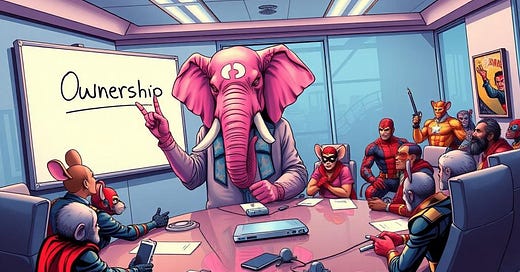Ownership: The Elephant That No One Owns
Trust, Ownership and Accountability in High-Performing Organizations
Imagine a self-driving car crashes. Who is responsible?
The software that made the decision?
The company that built the software?
The programmers who wrote the code?
The testers who validated it?
The car manufacturer that sold the vehicle?
Or the passenger sitting in the driver’s seat (who had no control but was expected to “monitor” things)?
This isn’t just a legal or ethical debate, it’s a foundational question of ownership.
How often are you held accountable for things you had no real control over?
How many times have you heard “you own the results” without anything being mentioned about the authority to make key decisions?
And when things go wrong, how often does the blame get passed around instead of real accountability being taken?
Trust —> Ownership —> Accountability
Ownership doesn’t stand alone. It’s built on trust.
Accountability doesn’t stand alone. It’s built on Ownership.
If I am truly an owner of something, it means others trust me to make decisions. They trust me I’ll take it seriously, and act in the best interest of my colleagues, the team, and the organization.
At the same time, accountability only works when it’s paired with ownership. You can’t hold me accountable for something I don’t have no control over. That would be like blaming the driver in the example above.
But this dichotomy isn’t new. History is filled with failed systems that demanded accountability without granting real power.
Take the American Revolution, for example. It was founded on “no taxation without representation” —> a direct rejection of being held responsible for outcomes (taxed) without having a say in decisions (representation).
From empires to corporations, whenever people are expected to take accountability without authority, the system eventually breaks. Because accountability without ownership isn’t leadership, it’s only control - and control doesn’t build success, it only delays failure.
1. Axiom - ownership sits where the work happens
Simply said, if you’re doing the work, you own the decisions that come with it.
Ownership can’t be assigned to someone who doesn’t actually execute the work —> A manager can provide direction, but they can’t “own” the outcome of a product release the same way a product team does.
This means:
Different levels of ownership exist. A product manager owns the vision, an engineer owns the technical implementation, a designer owns the user experience. Ownership is layered but clear.
Trust = Ownership = Accountability. If I trust you to do the work, I also trust you to make decisions. And in return, you take full accountability - whether for success or failure.
Fairness is key. If something goes wrong, you own it. If it succeeds, you get the credit. That’s how strong, high-trust teams operate.
2. Leaders Must Let Go
One of the biggest blockers to real ownership is leadership that can’t let go. If every decision must be approved at the top, ownership is just an illusion. Leaders who truly believe in ownership empower their teams, set clear goals, and then step back to let them figure out how to achieve them.
Micromanagement kills ownership. If I know my decision will be overturned, why should I take ownership at all?
This is also why many organizations try to “fix” ownership with frameworks instead of culture. It’s easier to roll out a fancy framework like Product Operating Model than to build real trust and decision-making autonomy. A structured model provides clarity - but without true ownership, even the best frameworks turn into bureaucracy.
Ownership doesn’t come from a slide deck. It comes from leaders who trust their teams, and are willing to step back.
3. The HiPPO Problem
And when leadership doesn’t let go, another force takes over: the HiPPO (Highest Paid Person’s Opinion).
HiPPOs swoop in, override decisions, and strip teams of real ownership. They want accountability, but by taking over, they eliminate it.
When a senior leader dictates a decision and things go wrong, does the team really own that failure? No—because the decision wasn’t really theirs.
If you want real ownership in your organization, you have to tame the HiPPOs. Leaders must trust their teams, step back, and let the people doing the work make the decisions that matter.
So, who owns the elephant?
The truth is, everyone sees it, but no one steps forward to claim it.
The CEO sets the tone for ownership, but they can’t be the only one who owns it.
Real ownership isn’t given from above, it’s taken by those willing to step up.
Ownership isn’t a process. It’s not even a framework. And it definitely shouldn’t be a buzzword. At its core, ownership is the right to make decisions and the courage to stand by them —> it’s the trust to say, “This is mine” and the accountability to say, “I’ll make it better”.
Because in the end, a team that owns its work builds products that matter.
And an organization that fears ownership doesn’t just fail, it makes itself irrelevant.



